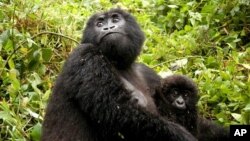While efforts continue to contain the Ebola outbreak among people in West Africa, researchers have a new technique to study Ebola among the Great Apes. Thousands of the primates are believed to have died from the disease in recent decades. The research could help predict where Ebola outbreaks might occur among humans.
Researchers have been studying Ebola in the wild for 30-years, but they say there’s still much they do not know. It’s difficult to safely capture wild animals in Africa’s rainforests, let alone take blood and tissue samples from them.
Dr. Kenneth Cameron is a Wildlife Conservation Society field veterinarian, who took part in the research. He spoke from the Republic of Congo capital Brazzaville:
“We’ve been doing Ebola ecology studies for a long period of time trying to further determine where Ebola comes from. How it spills over from presumed reservoir species to Great Apes in particular. And what effect it has specifically on those Great Ape populations. We know that it has some pretty devastating effects on Great Ape populations. We believe well in excess of 80-percent mortality when there is an Ebola epizootic amongst Great Apes.”
An epizootic is an epidemic among animals.
In the current West Africa Ebola outbreak, fruit bats are the prime suspect for being the source of the virus. Fruit bats are known as a reservoir species. That is, they can carry the Ebola virus and yet not get sick. Cameron said it’s not the same with Great Apes.
“We believe that Ebola virus has killed probably tens of thousands of Great Apes in the past 20 to 30 years in Central Africa. So it’s those populations that we’re concerned about. And what we wanted to find out is what individuals among those species and what populations of gorillas and chimpanzees have actually been exposed to Ebola virus,” he said.
Researchers believe Great Apes can become infected by being in close quarters with other animals that have similar feeding habits – animals that may carry the virus.
“They’ll be eating out of the same tree at the same time, for example. We typically call those trees magnet trees. Because when a magnet tree starts fruiting – for example, a fichus tree – the figs that are produced attract all kinds of animals. So many different species, including both the reservoirs and the susceptible hosts for Ebola virus. That is to say the fruit bats and gorillas and chimps,” said Cameron
Infected bats may contaminate the tree’s fruit with their saliva and spread the virus through urine and feces on the ground.
Researchers sid that “understanding Ebola’s distribution in space and time is a matter of great importance to both human health and conservation communities.”
So, what is the new technique to study Ebola among Great Apes? The answer: studying fecal samples – primate droppings.
Cameron said, “What we’re looking for is just feces, fresh feces, that have been dropped by Great Apes. Great Apes move around feeding and what not throughout the day. They obviously drop their feces as they go. We typically send teams out in what we call directed reconnaissance swab surveys. So it’s just a survey where they go and they just wander through the forest in areas where we know there are Great Apes looking for the feces – or they use GPS coordinates, compass coordinates, to direct themselves from one point to the next looking for feces as they go.”
Depending how fresh it is – it’s considered fresh if its 12 to 24 hours old – the fecal sample is frozen and sent for testing back in the United States.
“Unfortunately,” Cameron said, “we’re not set up to be running the testing here in country. Our partners in developing this technique at the National Institutes of Health would run them in their laboratory. So, usually from the time of collection to the time of testing to know whether or not they had been exposed is usually weeks. We’re hoping to transfer that technology to our laboratory here in Brazzaville in Republic of Congo where we can do the testing in a much more timely basis.”
Apes are like humans in that they develop antibodies during a viral infection. It’s not known how long those antibodies remain in apes that survive infection or whether they can protect an ape from future outbreaks. But the samples may help predict potential Ebola hot zones.
“A lot of disease projections – where diseases may erupt – comes out of mathematical epidemiological models that are conducted. We need more data to feed into these models. If we don’t have good data fit into them the results that we get out are not going to be meaningful. The data that we’re collecting here can feed into those mathematical models. It can help us predict where Ebola may occur next by determining which Great Apes have already been infected. So we know Ebola has been in a given region,” he said.
The Wildlife Conservation Society field veterinarian said typically in Central Africa human Ebola outbreaks follow epizootic outbreaks. Contaminated bushmeat is usually to blame.
Cameron said when researchers found evidence of Ebola among dead Great Apes they educated local communities about the disease – and asked them to report any wildlife carcasses they found so they could be examined for Ebola. Health officials were also notified. Studying fecal samples could create a better early warning system.











